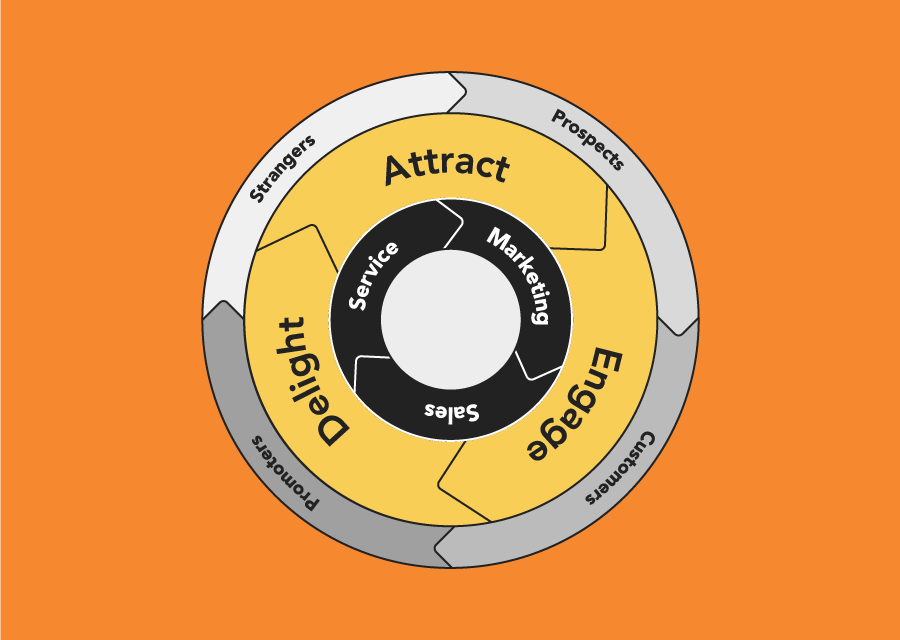How to Increase Sales Velocity with a Flywheel
Why have so many B2B companies replaced their sales funnel methodology with the Flywheel Method?
The simple answer: because flywheels work!
The Flywheel Method is quickly becoming the method of choice for driving sales because it is so much more sophisticated than a simple funnel.
- How Does a Sales Flywheel Work?
- Let’s Talk About Momentum and Velocity.
- 5 Tips for Increasing Velocity
- At ThinkFuel, We Use HubSpot to Provide Momentum to the Flywheel.
How Does a Sales Flywheel Work?
HubSpot explains that a flywheel is used “to explain the momentum you gain when you align your entire organization around delivering a marketable customer experience.”
Don’t forget that word: momentum. We’ll get back to explaining the role of momentum shortly!
A sales flywheel features three concentric circles, each representing a different aspect of the sales cycle.
Cycle #1: Your Teams
The individuals or teams within your company make up the first cycle. That’s because everyone within your company needs to work together.
Even though they have distinct responsibilities, your marketing, sales, and service departments must see themselves as a cohesive part of the flywheel. The marketing team generates qualified leads, sales reps focus on closing deals, and customer service provides extraordinary customer-focused care, but the cycle perpetuates itself.
Your customer service team must know how your services were marketed. Sales teams must delight customers. Marketers must know as much as their colleagues in sales and customer service about the value your company delivers.
Cycle #2: The Buyer’s Journey
This next circle on the flywheel is all about guiding the customer on their journey. During the Awareness Phase, potential buyers realize that they have a problem that is in need of a solution. They move into the Consideration Phase, which involves researching solutions and weighing options. And finally, at the Decision Phase, the buyer makes a purchase — and if your sales pipeline is working, they make that purchase from you!
This part of the flywheel walks alongside customers. First, it attracts them to your company, particularly through your website and inbound marketing strategies. Second, it engages them and makes them feel connected and valued to your company. Third, it delights them as they make their purchase and become a repeat customer.
Cycle #3: Turning Strangers into Promoters
This final wheel goes like this: Turn Strangers into Prospects, Prospects into Customers, and Customers into Promoters...and those Promoters help you bring in more strangers!
Let’s Talk About Momentum and Velocity.
There are two opposing forces that affect your flywheel: velocity and friction.
Velocity — or momentum — is the force that spins your flywheel forward. It’s what helps you generate quality leads and improve your conversion rates.
Friction is anything that slows the sales process down. A clunky website, slow customer service, poor sales metrics, an average sales cycle that is lethargic — these are some of the things that can slow your flywheel down. In this post, we’re focusing on building velocity, but here are some tips from HubSpot about reducing friction, especially in your lead generation and conversion processes.
Sales velocity, on the other hand, is measured using four metrics:
- The number of opportunities in your pipeline
- Your win/conversion rate
- The deal value (average deal size)
- The length of the sales cycle (in months)
The sales velocity equation looks like this:
5 Tips for Increasing Velocity
There are a lot of ways to increase velocity, but let’s look at some of the things that those of us at ThinkFuel have seen work over and over again for our clients.
1. Use Social Intelligence
Consider using one or more of the high-quality social intelligence tools that can help you understand your target market’s values and motivations by studying their social media habits and activity. This allows you to build custom marketing strategies to cycle them through the flywheel!
2. Get Your Whole Team Working Together
If you silo your sales team away from your marketing team, your marketing team away from your customer service team, and so on, you are going to create friction. Get your whole team working together to build velocity!
Because one of the components of the velocity equation is the length of the sales cycle, think about how a company where everyone is working together can help to shorten that cycle.
3. Personalize Everything You Send Out
We talked about this in a recent blog post about account-based marketing: personalize every single email and message that you send out. Hubspot is an incredible tool for this. It allows you to automate the personalization process so that everyone you communicate with gets that feeling of inclusion without you having to sacrifice valuable workforce time.
4. Host Events
You don’t have to host in-person events these days, which means you are not limited to the people in your geographical area. Host webinars, lunch and learns, and other events that are custom-tailored to your target market. Provide value to your leads so that they are getting something from you, even when you are marketing to them.
5. Provide Valuable Content
Events are just one way to provide value. You can also provide value throughout your marketing process: accurate and meaningful information, personal connections, solutions to problems, special content offers, discounts, memberships, hard-to-access info, engaging content, and more.
At ThinkFuel, We Use HubSpot to Provide Momentum to the Flywheel.
HubSpot is the premier software tool for sales, marketing, and service teams to use as they ditch the funnel and embrace the flywheel.
When you’re ready to increase sales and grow your online business, talk to us! We’re ready to get started. Are you?
Table of contents
Share this
You May Also Like
These Related Stories

It's Time to Replace Your Funnel with a Flywheel

The Executive's Guide to Sales Automation
